This is a Veteran Owned site
![]()
 |
The Bosch 1619EVS kit comes with the router, height adjuster extension, 1/4" & 1/2" collets, wrench and dust collection pieces. All are well made. Click image to enlarge |
Bosch 1619EVS 3-1/4Hp Plunge Router
Big power with high-tech versatility
Text & photos by Tom Hintz
Big horsepower routers packing 3Hp or more used to be a luxury in the home woodshop. In recent years router bit manufacturers developed ever-increasing numbers of large-diameter profiles, making powerhouse routers a common feature of the woodworking landscape.
The Bosch 1619EVS is not only powerful but also loaded with features that help the woodworker apply its extensive capabilities in the home woodworking shop. Versatility is crucial to modern woodworkers who need to get the most bang for their router dollar. The Bosch 1619EVS is evidence that Bosch was listening.
Controlling the Power
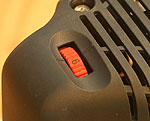 |
The electronic speed control is just the beginning. Internal circuitry maintains the selected RPM when the loads of cutting wood try to slow it down. Click image to enlarge |
Bosch was one of the pioneers in the development of electronic motor controls and continues to build circuit-based fanciness, many operating behind the scenes into their routers. The Bosch 1619EVS comes with a full compliment of those technologies.
Most evident is the speed control dial on the top of the motor housing. It has numbers from 1 to 6 indicating steps in the 8,000 to 21,000 rpm range. A chart in the instruction manual provides the following breakdown: 1=8,000 – 2=9,000 – 3=11,000 – 4=13,000 – 5=17,000 and 6=21,000 rpm.
The speed control dial does not have detents or built in stops, making it infinitely adjustable. That can be important because we often find that a bit works best running a little above or below one of the major speed marks. This speed control allows the user to dial in the exact speed needed for the combination of bit and wood density.
A trigger-style On/Off switch in the right handle is comfortably placed and has a positive-feeling detent that prevents accidental startup. A shielded button on the inside of face of the same handle allows locking the trigger in the On position when used in a table equipped with an external switch. Squeezing the trigger again automatically disengages that lock.
Less noticeable are the Constant Response and soft start circuits. Soft start simply reduces the initial torque response generated when a 3 1/4Hp motor comes to life. Simple put, Soft Start gradually increases RPM from zero to the speed dialed in at the speed control dial. Tough all this happens in two to three seconds, it makes the router far easier to handle on startup.
The Constant Response feature is a little more involved. This circuitry monitors the rpm and if it begins to drop below the set value, electrical power is added to the motor to maintain the rpm selected at the dial. All this happens so quickly you may never know that it’s working other than the router does not slow down under load.
Collets & Bit Changing
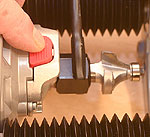 |
The pushbutton spindle lock makes changing bits a simple, one-wrench job. the spindle has detents 180-degrees apart, making this an even easier job. Click image to enlarge |
The Bosch 1619EVS comes with ¼” and ½” collets. Both are self-extracting and precisely machined to fit the bit shanks closely. The result is that bits stay put while in use yet pop free for easy removal when the collet nut is backed off. As is common with self-extracting collets, the nut has to be loosened through a second “tight” spot that actually breaks its grip on the bit shank.
Changing bits on the Bosch 1619EVS is a one-wrench job thanks to a built-in button that locks the spindle. A pair of detents, 180-degrees apart accept the pin, actuated by the push button.
Located at the bottom of the motor housing, the push button is easy to reach and operate whether the router is upright or inverted as when mounted in a table.
Versatile Base
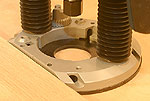 |
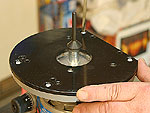 |
The large-diameter base (left) is very stable and the flat (opposite operator) is great for following fences for long straight cuts. Bosses are cast in for the Bosch guide fence also. The baseplate mounting holes have enough "slop" in them to allow centering templet guides (right) perfectly. Click images to enlarge |
|
The large 7 ½”-diameter base provides exceptional stability for the Bosch 1619EVS in handheld situations. The base also becomes a wide, stabilizing flange when bolted up in a table mount. A large flat edge on the base, opposite from the operator makes following clamped-on fences more accurate. Bosses are cast into the base that accept the Bosch RA1054 guide fence, available separately.
The plastic subbase has enlarged mounting holes that permit aligning it and guide collars to the spindle centerline. This is an easy task with the optional (RA1150) Bosch Centering Cone. The centering Cone has ¼” and ½”-diameter ends for use with either collet. This is an important feature as a miss-aligned guide collar can ruin sensitive joinery such as dovetails or other tasks in which a guide collar follows a template. The Bosch 1619EVS kit includes a tool-free adapter for the Bosch guide collars.
The base and subbase have mounting holes for the optional RA1170 Edge Forming Dust Extraction Hood. This dust hood encloses the under-router bit area during many hand-held jobs such as edge forming. The RA1170 comes with vacuum adapters to fit 1 ¼” and 1 ½”-diameter hoses.
The plastic subbase plate has a 2”-diameter opening to handle nearly any bit designed for handheld use. With the subbase removed, the base itself has a huge 3 ¾”-diameter opening that provides clearance for using bits up 3 ½”-diameter when mounted in a table.
Dust Collection
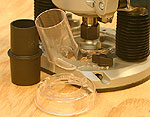 |
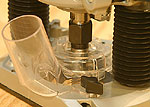 |
The included dust collection pieces (left) do a good job of reducing the mess of routing. The secondary dust shroud (installed at right) closes the area in more when using small-diameter bits. Click images to enlarge |
|
The Bosch 1619EVS comes with a two-piece dust collection shroud. The main shroud attaches to the base with a single thumbscrew and provides good coverage for most profile-style bits. It has a 2 ½”-diameter opening to accommodate most bit sizes that can be used in the handheld mode. This primary shroud section has an extended port sized to fit 35mm hoses. Also included is an adaptor designed to attach 1 ½” or 1 ¼”-diameter hoses to the shroud.
When using smaller bit diameters or straight bits, a second shroud can be snapped into the primary one. This second piece reduces the opening to about 1 3/8” and extends the dust shroud upwards less than ½”.
High-Tech Plunge Mechanism
 |
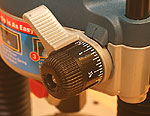 |
The fine and coarse plunge rod controls (left) give you lots of options. The coarse dial (right) makes changing the plunge rod height with accuracy simple. The lever outside of the dial "shifts" between the coarse and fine adjustment modes. Click image to enlarge |
|
The plunge action on the Bosch 1619EVS is smooth and predictable thanks to precision-ground columns and dual bearings on each side. Flexible rubber boots protect the columns from debris but can be pulled down to clean out the inevitable fine dust that will eventually build up inside.
The Bosch 1619EVS has an adjustable plunge rod and multi-position turret similar to those found on most plunge routers. However, that is where the similarity ends. Bosch has engineered the Bosch 1619EVS plunge system to make it more accurate and easier to use in both the handheld and table mounted modes.
While the plunge rod and turret can interact normally, coarse and fine adjustment systems are available and selectable with a flip of a front-mounted lever. With the coarse adjustment system engaged the plunge rod is positioned up or down with a dial located near the bottom edge of the motor case. Even though this is intended for coarse adjustments, a repositionable ring at the base of this knob can be adjusted to zero the standard scale wherever the starting point is needed. Then, the plunge rod can be adjusted a known amount up or down quickly and accurately using the graduations on that dial.
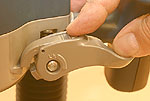 |
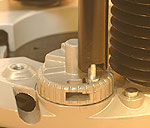 |
The plunge lock has a special lockout (left) that makes using the fine height adjustment far easier in a table mount. The plunge rod can be locked into the turret (right), connecting the fine adjustment feature to the base directly. this makes under table bit height changes far easier. Click images to enlarge |
|
Move the adjustment control lever to the other side and the fine adjustment system is engaged. A dial near the top of the motor is used to make height changes and also has a repositionable calibrated ring that makes quantifying the amount of change easy. A plug-in extender with a large-diameter handle is included to make fine adjustments easier on the hand whether in the handheld or under table modes.
A unique feature is being able to lock the plunge rod into the turret by inserting its end into a keyhole-shaped opening and giving the turret a slight turn. This directly connects the coarse and fine adjustment systems to the base. While this can be used in the hand-held mode for exceptional bit depth control, it is especially handy for using the fine adjustment with the router in a table mount.
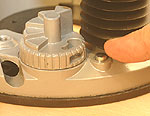 |
This little button magically eliminates the plunge spring pressure which makes changing to a table mount fast because you do not have to take anything apart! Click image to enlarge |
Generally, the coarse adjustment is used to set the plunge rod in relation to the stepper turret. The repositionable scale brings lots of precision to what used to be a very hit and miss depth setting.
The fine height adjustment system is great for under table mounts but can also be used in the handheld mode with the plunge rod locked into the base. This allows superior control over tiny bit height corrections that can be very handy when fitting parts or matching an existing cut.
While most routers require removal of the plunge springs to make under-table height adjustments less of a test of strength, the Bosch 1619EVS has “Spring Defeat” button on the base that eliminates the spring pressure without having to take anything apart. Align the keyhole opening in the turret with the button and raise the plunge rod fully so the motor can be pushed all the way down. With the motor all the way down, depress the Spring Defeat button and let the motor move up slightly. The plunge springs are held fully compressed, removing their tension on the motor assembly. To reengage the plunge springs simply push the motor all the way down and the Spring Defeat button releases automatically.
Though the Bosch 1619EVS does not have through-the-table height adjustment capabilities, the combination of the fine adjustment system along with the Spring Defeat mechanism make reaching under to change bit height a much easier task and one that can be done with a high degree of accuracy.
In The Shop
Video Tour! |
Though not a featherweight, at 13.2 lbs the Bosch 1619EVS is far from heavy. Between the large surface area of the base and the ergonomically designed handles, the Bosch 1619EVS is easy to control in the handheld mode. The handles are angled just enough to keep the operators wrists in a comfortable position in most routing situations.
All of the controls work as expected and are in easy to reach locations. The plunge release/lock lever is spring loaded with enough tension to insure locking the power head when released. The operator does not have to manually seat it to establish a lock.
Either Bosch is minimizing the horsepower this router generates or this is what 3 1/4Hp really feels like. In either case, power was never an issue during the evaluation. It easily handled all of the bits we tried, including my largest panel-raising bits. Whatever the chore, the Bosch 1619EVS seemed to be just cruising along – and doing it smoothly.
The dust shroud does a good job at collecting the majority of the debris generated. When hooked to a shop-vac, this shroud directed nearly all of the chips away from the bit and left little to sweep up later.
While all of the features worked very well, the coarse/fine adjustment systems built into the plunge rod are especially noteworthy. Whether used in the handheld or table mounted mode, being able to switch between coarse and fine height adjustment so easily is a real plus. In addition, locking the plunge rod to the base allows using the fine adjustment feature to make tiny bit height changes easily and with extreme accuracy.
While big horsepower routers frequently live in a table mount, woodworkers often stretch tool dollars by using them for larger handheld jobs also. The Spring Defeat button is a real stroke of genius that makes this dual use far easier and faster.
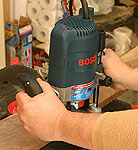 |
 |
Whether used in the handheld mode (left) or mounted in a Bosch table (right, the new RA1181 table), the Bosch 1619EVS handles anything you can throw at it easily and accurately. Click images to enlarge |
|
Throughout our testing the Bosch 1619EVSperformed flawlessly. Regardless of how small or large the bit was, the Bosch 1619EVS handled them all with ease.
I used the Bosch 1619EVS in the handheld mode for edging and it feels surprisingly light for such a powerful router. The large flat on the base makes following a clamped-on fence very easy and the handles provide a comfortable grip that also give a good sense of control.
The Bosch 1619EVS is equally at home in a router table. The power and Constant Response circuitry let you concentrate on making the cut at the best feed rate without worry of stalling the motor. In all situations, the Bosch 1619EVS provided smooth, consistent power to whatever task was at hand.
Conclusions
The Bosch 1619EVS is a top-notch, well-built router with unique capabilities that set it apart from the crowd. The dual height adjustment modes and the Spring Defeat system make the Bosch 1619EVS an exceptionally user-friendly tool that brings as much accuracy to the job as it does power. Whether used strictly in a router table or multi-purposed for handheld jobs, the Bosch 1619EVS has all the power, features and durability woodworkers need – and demand.
With a street price of $303.00 (7-20-2006) the Bosch 1619EVS is a very good value for any shop but can be a real budget-saver for single router shops or when getting the biggest bang for the tool buck is important.
Visit the Bosch web site – www.boschtools.com
Have a comment on this review? –Email Me!
All written, photographic and drawn materials are property of and copyright by NewWoodworker.com LLC 2000-2019. Materials may not be used in any way without the written permission of the owner.
